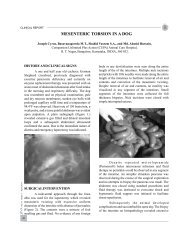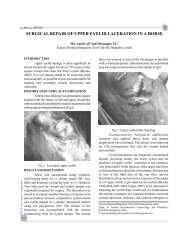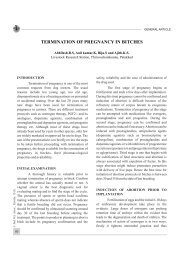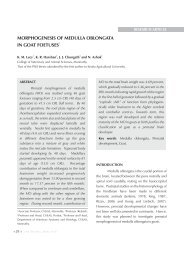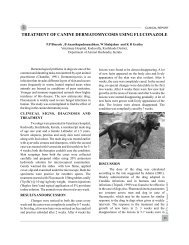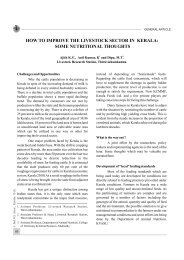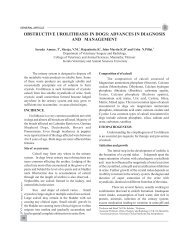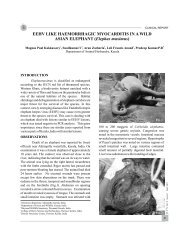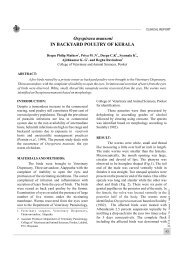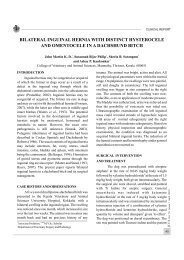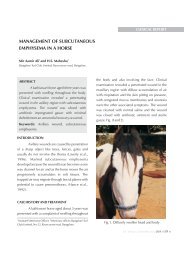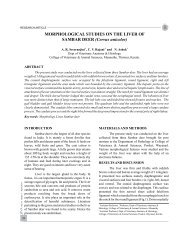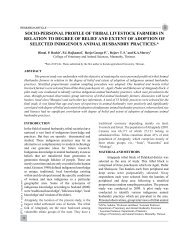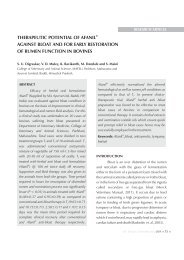2012 Jiva April Cover 220 GSM Art Card Glossy ... - Jivaonline.net
2012 Jiva April Cover 220 GSM Art Card Glossy ... - Jivaonline.net
2012 Jiva April Cover 220 GSM Art Card Glossy ... - Jivaonline.net
You also want an ePaper? Increase the reach of your titles
YUMPU automatically turns print PDFs into web optimized ePapers that Google loves.
GENERAL ARTICLEHOW TO IMPROVE THE LIVESTOCK SECTOR IN KERALA:SOME NUTRITIONAL THOUGHTS1 2 3Ajith K.S ., Anil Kumar, K and Dipu, M.T .Livestock Research Station, Thiruvizhamkunnu.J. Ind. Vet. Assoc., Kerala. 10 (1)Challenges and OpportunitiesWhy the cattle population is decreasing inKerala in spite of the increasing demand of milk isbeing debated in every animal husbandry seminars.There is a decline in total cattle population and thebuffalo population shows a more rapid decliningtrend. The demand by consumers are not met byproduction within the state and the human populationis increasing day by day. There is always a deficit of25 percent in milk as far as requirement is considered.In Kerala, out of the total geographical area of 38.86lakh hectare, 18 percent of the land area is barren landor uncultivated land area or cultivable waste areawhich can be utilized in one way or other forimproving the livestock sector.One major problem faced by Kerala is theweak feed and fodder base. With the shift in croppingpattern of Kerala, the area under rice cultivation hascome down by more than 50 percent over the last twodecades leading to drastic reduction in theavailability of straw for feeding cattle. It is estimatedthat the state produces only 60 per cent of theroughage requirement for cattle in Kerala.(economicreview, Kerala 2010) As a result roughage in the formof straw is being brought in to the state from adjacentstates at an exorbitant rate.Kerala has got a unique distinction amongIndian states that, it is the only state which usesreadymade concentrate as the major feed resource,1. Asistant Professor, Livestock Research Station,Thiruvizhamkunnu.2. Associate Professor & Head, Livestock Research Station,Thiruvizhamkunnu.3. Assistant Professor, Department of Animal Nutrition, Collegeof Veterinary & Animal Sciences , Mannuthy.instead of depending on “homemade” feeds.Regarding the cattle feed concentrate, which willhave to supplement the shortage in quality fodderproduction, the current level of production is notenough to satisfy the requirement. Now KCMMF,Kerala Feeds Ltd. and a few private players aretaking conscious steps for facing this challenge.Dairy farmers in Kerala have tried to adjustwith the situation by restricting the number of cattleand by preferring high yielding cross breds. This isevident from the steady increase in the proportion ofcrossbred animals, which Kerala achieved during thelast three decades.What is the way out ?A joint effort by the researchers, policymakers and implementing agencies is the need of thehour. Some thoughts which may be valuable arenarrated here.Development of “local” feeding standardsMost of the feeding standards which arebeing used today are developed for conditions notdirectly related to feeding practices prevailed underKerala conditions. Farmers in Kerala use a widerange of low quality and unconventional feeds. Asthe partitioning of nutrients are complex and aregoverned by a number of factors including thegenotype of the animal, quantity and quality of feedand the environment, the possible solution is to givenutritional recommendation to the farmers under ourmanagemental conditions and some efforts are beingdone by the Department of Animal Nutrition,KVASU.66



